Papers by Michael Kirchner
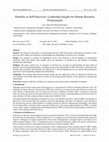
Business and Management Research
Purpose: The purpose of this paper is to help Human Resource (HR) Professionals understand six el... more Purpose: The purpose of this paper is to help Human Resource (HR) Professionals understand six elements of self-discovery and to apply those elements in understanding the relationship of self-discovery to humility.Design: This summary is prepared by independent writers who specialize in the development of interpersonal leadership skills and includes their insights about the importance of self-discovery and humility in building interpersonal relationships.Findings: This paper explores how six elements of self-discovery can apply in understanding the three pillars of humility and in incorporating humility in building interpersonal relationships for HR professionals. Based upon the literature about humility and leadership, the utilization of a self-development process can inform HR professional's approach toward strengthening interpersonal relationships.Originality: This briefing offers HR professionals insight into how application of the six elements of self-discovery can contrib...

Military Veteran Employment, 2021
Members of the military’s National Guard and Reserves acquire numerous competencies and technical... more Members of the military’s National Guard and Reserves acquire numerous competencies and technical skills through their training that could be valuable to civilian organizations. For employers seeking to hire and retain National Guardsmen and Reservists, understanding the challenges faced while managing dual employment can aid organizations that are striving to become or improve their support of employees also serving in a Reserve component. This chapter reviews distinctions between the National Guard, Reserves, and active duty before outlining legal rights of employers and service members who work for nonmilitary organizations. The chapter then provides a business case for employing National Guardsmen and Reservists while describing prominent corresponding challenges experienced by all stakeholders. It concludes with best practices for organizations striving to be military friendly to National Guardsmen and Reservists.
Journal of human resources education, 2018
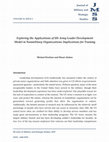
Journal of Military and Strategic Studies, 2019
The United States Army’s leader development program offers new opportunities to examine how leade... more The United States Army’s leader development program offers new opportunities to examine how leaders are developed within the traditional workforce. Leader development is at the forefront of Army training and is coordinated through an institutional, operational, and self-development domain. Each domain contributes toward a holistic leader development program which prepares soldiers to be lifelong leaders. Veterans transitioning out of the military are often credited as possessing the leadership skills employers seek, though exploration of the process used to develop leadership attributes in soldiers has been minimal. Upon comparing the Army’s leader development program with other private sector leadership development training, similar goals were identified though the Army’s approach is distinguishable. This paper is an analysis of the U.S. Army’s leader development process and makes comparisons with leadership development in the traditional workplace. Three propositions are presented...
Journal of Veterans Studies, 2021
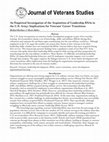
Journal of Veterans Studies, 2019
The U.S. Army incorporates an extensive leader development program as part of its everyday traini... more The U.S. Army incorporates an extensive leader development program as part of its everyday training. Servicemembers obtain a set of knowledge, skills, and abilities (KSAs) during their enlistment and maintain the attributes upon transitioning into the non-military workforce. Although employers in the U.S. argue the number one reason they choose to hire veterans is for their leadership skills, scholars have not examined the KSAs veterans believe they have acquired during their service. This manuscript presents findings from a qualitative study of ten Post-9/11 Army veterans who spoke about their leadership KSAs acquired while serving and their preparation for transitioning into the non-military workforce. Three themes: (1) difficulty articulating leadership KSAs, (2) impactful leadership behaviors, and (3) inadequate transition support were revealed through data analysis. The paper explores the linkages between U.S. Army leader development and career transitions, offers implications from the findings for organization management, and proposes directions for research in the area of veterans studies.
New Horizons in Adult Education and Human Resource Development

The existing literature presents ample studies on leaders and leadership development in the Unite... more The existing literature presents ample studies on leaders and leadership development in the United States Army. The contribution of many great military leaders of the U.S. are widely recognized both by the military community and the society at large. Reviewing the history of leadership development (LD) in the U.S. Army provides an opportunity to analyze American soldiers’ development and transformation as strong leaders. Although U.S. Army training and its value systems, in many ways, have remained fundamentally the same with focus on hierarchy and structure, LD has been repeatedly refined, reframed, and redesigned based on the needs of the time and expectations of the leadership. This paper presents a review of the LD training in the U.S. Army to identify potential opportunities for the military of the Republic of Korea. It focuses on LD throughout critical periods in the history of the U.S. Army and illustrates how LD training has evolved historically. The paper also explores how Human Resource Development (HRD) as a discipline of study and its functions may be instrumental in LD by analyzing the U.S. Army’s approach to LD, leadership training, organizational culture, and career development. Implications of LD for security and defense strategies are also discussed.
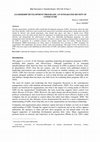
Though organizations worldwide utilize leadership development programs (LDPs), discussions about ... more Though organizations worldwide utilize leadership development programs (LDPs), discussions about the topic have been sporadic. LDPs have only recently been analyzed by researchers and questions remain about why they should be offered; who should participate; what should take place; and when it should occur. While organizations across the globe preach about the importance of employing strong leaders, few can successfully measure and demonstrate the effectiveness of their own leadership development programs. As such, management teams find themselves in a tough position when it comes to spending training dollars in general and for LDPs in particular. In a troubled economy with margins tighter than ever before, Human Resource Development (HRD) professionals are being asked to demonstrate how investing in LDPs strengthen the organization. Not surprisingly, the answers remain vague and uninspiring. This paper reviews the literature on LDPs, discusses major issues inhibiting the effectiven...
New Directions for Adult and Continuing Education, 2020
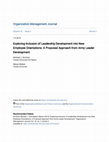
Organization Management Journal, 2019
Regardless of industry, organization leaders recognize the need for a strong leadership pipeline ... more Regardless of industry, organization leaders recognize the need for a strong leadership pipeline and a culture of sustained leader development, and the U.S. Army is no exception. Beginning in basic training, Army leaders offer soldiers leader development training through various methods, including defining leadership expectations, providing experience-based developmental exercises, and offering self-development opportunities. The early introduction is part of a continuous leader development regimen engrained in military service, and-as a result-military veterans are often credited by employers for their leadership skills. This paper, through exploring Army leader development, proposes a framework for introducing leadership development during new employee orientations based on U.S. Army strategies. Though the proposed framework offers three leader development strategies for inclusion in new employee orientation, barriers exist which may impede successful application, and are discussed. Additionally, the authors identify three propositions and propose future research opportunities for integrating Army leader development in new employee orientations.
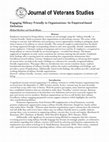
Journal of Veterans Studies, 2018
Employers interested in hiring military veterans are increasingly using the "military friendly" o... more Employers interested in hiring military veterans are increasingly using the "military friendly" or "veteran-friendly" labels to promote their organizations to job-seeking veterans. The terms, while inviting to veterans, lack definition and consistency across organizations, leading to ambiguity about what it means to be military or veteran friendly. This research sought to understand how the labels are being supported through corresponding initiatives and, more generally, identify commonalities across employers. A thematic analysis of programs and services used by 31 employers-recognized as being military or veteran friendly by an external agency-revealed four themes. The themes suggested an emphasis on early career transitions for veterans entering the job market. Combined, these findings offer a starting point for understanding how organizations demonstrate their friendliness toward military veterans. Employers interested in formalizing or advancing their support of veteran hires can look to the study's findings as a reference for currently-recognized military friendly organizations. This paper offers an introduction into veteran transition issues, explores foundational descriptions of military friendly, outlines the study's methodology and findings, and provides a series of implications. Additionally, based on the findings, the authors provide a model and working definition of military friendly organizations.

Industrial and Commercial Training, 2021
Purpose The purpose of this study was to identify primary issues related to employee onboarding a... more Purpose The purpose of this study was to identify primary issues related to employee onboarding and satisfaction in US-based manufacturing companies. Design/methodology/approach In total, 19 focus groups using semi-structured interviews with senior management, middle management, tenured employees and new employees were conducted with personnel from five manufacturing companies located in the Midwest USA. Onboarding procedures, training manuals, employee satisfaction surveys and performance evaluations were subsequently reviewed. Findings Insufficient onboarding, poor communication and a perceived lack of support were reported as satisfaction concerns by manufacturing employees. In addition, management had vastly differing perspectives regarding the work environment when responses were contrasted with those from new or tenured employees. Originality/value This paper reveals contributing factors that influence satisfaction early and throughout an employee’s tenure with small- to mediu...
Expertise at Work, 2021
For generations, military veterans have comprised a critical demographic of the United States-in ... more For generations, military veterans have comprised a critical demographic of the United States-in both proportion and contribution to society. World War II saw the largest number of US veterans in history, with 16 million having served during the war (Millet & Maslowski, 1994). In 1968, during a time when the United States still had a draft, roughly 3.5 million were serving on active duty (Bialik, 2017). That number has decreased to present levels of approximately 1.3 million (Department of Defense, 2020). Each of these generations have gone on to make an impact on the national and global economy. After World War II, roughly half of all veterans went on to own and operate their own business (Weisul, 2016). In fact, the last 75 years have seen at least two and a half

New Directions for Adult and Continuing Education, 2020
This chapter is a case study of how a community college located in the Midwestern United States h... more This chapter is a case study of how a community college located in the Midwestern United States has worked to increase student veterans' engagement with the campus community while simultaneously being enrolled in online degree programs. Student veterans experience unique transition challenges from the military into college. Moreover, the transition issues can be unintentionally exacerbated when student veterans enroll in degree programs offered entirely online. We consider strategies colleges can use to increase engagement of veterans primarily enrolled in online degree programs and outline their implementation. In addition, a discussion and corresponding challenges are outlined to help higher education administrators implement the engagement strategies with student veterans on their own campus. By developing a structured engagement system, higher education administrators can alleviate some of the transition issues plaguing student veterans and in turn improve engagement, retention, and graduation rates.
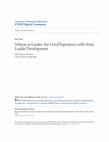
Human Resource Development Quarterly, 2017
This phenomenological study examined the lived leader development experience of Post 9/11 Army ve... more This phenomenological study examined the lived leader development experience of Post 9/11 Army veterans while serving in the armed forces. At least $10-$15 billion is spent annually on leadership development in the United States and human resource executives claim developing leaders is their number one priority over the next five years. Simultaneously, companies actively hiring veterans claim the former service member's leadership abilities are their most desired quality. Inspection of the Army's leader development program offers an opportunity for employers to integrate revised approaches in their own leadership development initiatives. A purposive sample of ten Army veterans-six males and four females-ranging in age from 18 to over 21 upon enlistment completed a leadership autobiography about their premilitary leadership experience. The former service members were subsequently interviewed about their leader development experience while serving in the Army. Four primary themes emerged and outlined the lived Army leader development experience: (a) consistent first Army experiences, (b) impact of observing, (c) performing is essential, and (d) we are all leaders despite not understanding the process. A discussion about the study's purpose, review of pertinent literature, data collection and analysis process, and findings are presented. The paper iii concludes with an examination of the findings; offers implications for the Army, veterans, and employers; and proposes future research.

Advances in Developing Human Resources, 2018
The Problem Employers view today’s science, technology, engineering, and math (STEM) program grad... more The Problem Employers view today’s science, technology, engineering, and math (STEM) program graduates as deficient in interpersonal skills that are essential for team and organizational performance. However, STEM programs continue to effectively engage in interpersonal skills development in college level, instead placing the responsibility of such development on employers. The Solution A competency modeling framework should inform the design of such education programs, and this article describes such a framework and an educational program that used the framework to identify needed interpersonal skills and successfully develop them in STEM students. The framework will help HRD (human resource development) professionals take an active role in identifying the competencies needed for STEM program graduate success. The Stakeholders The article provides HRD academics with a framework to identify competencies needed for workplace success in a given academic field. As education programs su...

Industrial and Commercial Training, 2017
Purpose The purpose of this paper is to explore how branches of the USA military conduct leadersh... more Purpose The purpose of this paper is to explore how branches of the USA military conduct leadership development of their members to build on existing knowledge of effective approaches. The military, often credited for its ability to develop leadership competencies, has been overlooked and offers a new context for consideration in training. Training strategies presented may offer organization leaders new insight into enhancing current leadership development programs. Design/methodology/approach A review of accessible military doctrine in recent decades was conducted to determine leadership development methodology for possible transferability into industry. Findings The military’s diverse perspectives on service member leadership development offered insightful methods for application in commercial training. Four development strategies were identified and are discussed. Research limitations/implications The purpose of the military is unique from non-military organizations and, as such,...

Uploads
Papers by Michael Kirchner